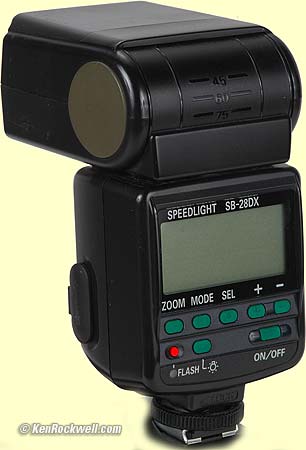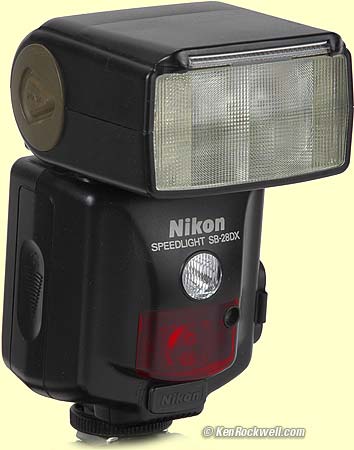get it used here
INTRODUCTION
The SB-28DX is light, fast and powerful. I loved mine.
It was introduced as the replacement to the SB-28 to add compatibility with the first Nikon Digital SLRs.
COMPATIBILITY
Film Cameras
The SB-28DX works perfectly on every Nikon film camera ever made in every mode. Nikon puts the brains for the flash system into their cameras, so the SB-28DX will get all the features and best performance of which your film camera is capable.
Digital Cameras
The SB-28DX works perfectly with the D2X, D2H, D100, D1X, D1H, D1 and Fuji S1, S2 and S3. "DX," or digital, is the SB-28DX' last name. These all use Nikon's original d-TTL system. The d-TTL system sucks and rarely gave consistent results, so many photographers use the non-TTL A mode instead.
With the D2X, D2H, D100, D1X, D1H, D1 and Fuji S1, S2 and S3 everything works exactly as it should.
The newest D200 D70, D70s, D50,use a much improved system for flash control, i-TTL. The SB-28DX doesn't support this and doesn't really work with these cameras unless you follow the instructions below. You'll get better results with the latest SB-600 or SB-800 with these cameras.
The D2X, D2H, are unique in that they support both i-TTL and d-TTL. You'll get better exposure consistancy with the newest SB-600 or SB-800 flashes on a D2 serties, howver your SB-28DX or other DX series flash will work just fine and possibly give better results for people and pets.
People and Pets
For people and pets you may get better results with the SB-28DX' non-TTL A mode than the i-TTL mode of the newer flashes. The i-TTL system's many preflashes ensure many people's and pet's eyes will be closed in every shot!
To use the SB-28DX with the D200 D70, D70s, D50, D2X and D2H you have to use the non-TTL "A" mode, which probably works better than the d-TTL mode of earlier digital SLRs anyway.
How to Use the SB-28DX With the Newest Digital SLRs
Of course manual mode works fine. You don't need to read this; just set it to manual. The SB-28DX exposure distance calculator works if you set the ISO and f/stop on the flash.
The SB-28DX isn't completely compatible with the D200 D70, D70s, D50, D2X and D2H. It doesn't work in any TTL mode and it doesn't completely communicate with the camera as we've come to expect. You have to set the ISO and apertures manually. If you're willing to press a few buttons you can use it in A mode, which honestly may work even better than the newest flashes for photos of people and pets:

1.) Put it on the camera.
2.) Turn it on and you'll see the ISO flashing. Press + or - until the displayed ISO matches your camera' setting (probably ISO 200). Press SELect to lock it and make it stop flashing.
3.) Press MODE a few times until you see "A."
4.) Press + and - to select the aperture at which you'll be shooting.
5.) Set this aperture on your camera and use M or A exposure mode.
6.) Press the ZOOM button a few times to set it to the widest lens you'll be using.
7.) Shoot away!
8.) You set exposure compensation by setting the camera and flash's apertures to different settings. For daylight fill flash set the flash to an aperture one stop larger than the camera's. This is the same as a -1 stop flash exposure compensation.
An advantage to this flash and this mode over the newest i-TTL system of the SB-600 or SB-800 is that it has no preflashes. The preflashes of the newest i-TTL system ensure perfect exposure almost every time, but also make a lot of people and pets blink, almost ensuring closed eyes for every shot. You'll not have this problem with the SB-28DX.
The camera and flash don't share ISO or aperture information, which is why you have to set them manually. They are smart enough to display the flash ready bolt in the finder. The bolt also blinks quickly if the flash had to fire at full power. The system is also smart enough to keep the newest digital cameras from exceeding their sync speeds when the flash is attached. It's not smart enough to ignore the flash if you make a shot before the flash recycles and it can't fire.
Remember that this section refers to using the SB-28DX with the very newest digital cameras made since 2004. Everything works perfectly between the SB-28DX and every film camera ever made as well as the D100, D1X, D1H, D1 and Fuji S1, S2 and S3.
HISTORY
Nikon discontinued this, remodeled it, raised the price and reincarnated it as the SB-80DX. The biggest difference is the way the buttons work on the back. The longer zoom range of the SB-80DX is meaningless. The wireless flash of the SB-80DX is great, except it does not work in TTL mode with the digital cameras. The SB-80DX in turn was replaced by the SB-800 and SB-600 in 2003.
Back to the SB-28DX. It's identical to the SB-28 with the addition that it works in TTL mode on the digital SLR cameras like the D100 and D1H.
One tiny difference is that the older SB-28 always keeps the flash fully charged when it's in the STBY (stand by) mode. That means it's ready to fire at full power with no delay even after being in the STBY mode for hours, but that also means the batteries will run down if you put the flash away and leave it for a week in that mode. The go-to-sleep-in-STBY mode is the standard way all these flashes ship.
The newer SB-28DX goes completely to sleep in STBY mode, so if I leave the SB-28DX in STBY mode I can always leave the flash turned on without the batteries running down. The downside to this is that after sitting all night it may take a few seconds to be ready for the first flash right after you wake up the system by tapping the shutter release, not a big deal. I prefer the SB-28DX to the SB-28 here. In other words, you never need to turn off the SB-28DX unless you don't want the flash to fire. I just always leave it turned on in the STBY mode in my bag and I never have to turn it on when I want to use it. Cool, eh?
Knowing this, just go see my SB-28 page for all about the SB-28DX.
SPECIFICATIONS
built-in wide panel
built-in white card
MEASURED POWER
Measured Guide Number (GN) in feet
| Zoom Setting | GN |
| 18 mm | 48 (40 + 1/2) |
| 24mm | 67 (80 - 1/2) |
| 35mm | 85 (80 + 1/6) |
| 85mm | 125 (110 + 1/6) |
This is about one stop less than specified, which is how almost all Japanese flashes measure. Most manufacturers cheat about the same amount hoping you won't notice a stop lost on print film.
This is a lot of power for any flash.

